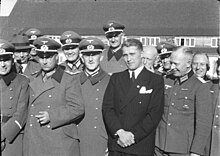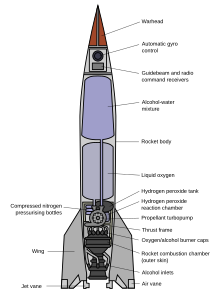Wernher Magnus Maximilian Freiherr von Braun ( VUR-nər von BROWN; German: [ˌvɛʁnheːɐ̯ fɔn ˈbʁaʊ̯n]; 23 March 1912 – 16 June 1977) was a German-American aerospace engineer[3] and space architect. He was a member of the Nazi Party and Allgemeine SS, the leading figure in the development of rocket technology in Nazi Germany, and later a pioneer of rocket and space technology in the United States.[4]
As a young man, von Braun worked in Nazi Germany's rocket development program. He helped design and co-developed the V-2 rocket at Peenemünde during World War II. The V-2 became the first artificial object to travel into space on 20 June 1944. Following the war, he was secretly moved to the United States, along with about 1,600 other German scientists, engineers, and technicians, as part of Operation Paperclip.[5] He worked for the United States Army on an intermediate-range ballistic missile program, and he developed the rockets that launched the United States' first space satellite Explorer 1 in 1958. He worked with Walt Disney on a series of films, which popularized the idea of human space travel in the U.S. and beyond from 1955 to 1957.[6]
In 1960, his group was assimilated into NASA, where he served as director of the newly formed Marshall Space Flight Center and as the chief architect of the Saturn V super heavy-lift launch vehicle that propelled the Apollo spacecraft to the Moon.[7][8] In 1967, von Braun was inducted into the National Academy of Engineering, and in 1975, he received the National Medal of Science.
Von Braun is a highly controversial figure widely seen as escaping justice for his Nazi war crimes due to the Americans' desire to beat the Soviets in the Cold War.[9][10][4] He is also sometimes described by others as the "father of space travel",[11] the "father of rocket science",[12] or the "father of the American lunar program".[9] He advocated a human mission to Mars.
Work under Nazi regime
In 1932, von Braun received a Bachelor of Science Degree in Mechanical Engineering from Technische Hochschule Berlin (now Technische Universität Berlin), Germany. During a period in 1931, von Braun attended the ETH Zürich in Switzerland. During this time in Switzerland, von Braun assisted Professor Hermann Oberth in writing a book concerning the possibilities of creating and manufacturing liquid-propellant rockets. Shortly after this, von Braun founded his own private rocket development business in Berlin, and through which made the first rocket fired by gasoline and liquid oxygen.[32]
In 1932, having caught wind of von Braun's rocket business, the German Army connected with von Braun to pursue basic missile research and weather data experimentation.[32] Von Braun said that the German government financed the development of test stands and facilities for experimentation in Darmstadt, Germany. In 1939, von Braun was appointed a technical advisor at Peenemünde Army Research Center on the Baltic Sea.[32]

First rank, from left to right, General
Walter Dornberger (partially hidden), General
Friedrich Olbricht (with Knight's Cross), Major
Heinz Brandt, and Wernher von Braun (in civilian dress) at
Peenemünde,
Province of Pomerania, in March 1941
In 1933, von Braun was working on his creative doctorate when the Nazi Party came to power in a coalition government in Germany; rocketry was almost immediately moved onto the national agenda. An artillery captain, Walter Dornberger, arranged an Ordnance Department research grant for von Braun, who then worked next to Dornberger's existing solid-fuel rocket test site at Kummersdorf.[39]
Von Braun received his doctorate in physics (aerospace engineering) on 27 July 1934, from the University of Berlin for a thesis titled "About Combustion Tests." His doctoral supervisor was Erich Schumann.[28]: 61 However, this thesis represented only the public aspect of von Braun's work. His actual thesis, entitled "Construction, Theoretical, and Experimental Solution to the Problem of the Liquid Propellant Rocket" (dated 16 April 1934), detailed the construction and design of the A2 rocket. It remained classified by the German army until its publication in 1960.[40][41] By the end of 1934, his group had successfully launched two liquid fuel A2 rockets that rose to heights of 2.2 and 3.5 km (2 mi).[42]
Von Braun continued his guided missile work throughout World War Two, and met with Adolf Hitler on several occasions, being formally decorated by Hitler twice, including being awarded the Iron Cross.[43]
At the time, Germany was highly interested in American physicist Robert H. Goddard's research. Before 1939, German scientists occasionally contacted Goddard directly with technical questions. Von Braun used Goddard's plans from various journals and incorporated them into the building of the Aggregat (A) series of rockets. The first successful launch of an A-4 took place on 3 October 1942. The A-4 rocket became well known as the V-2.[45] In 1963, von Braun reflected on the history of rocketry, and said of Goddard's work: "His rockets ... may have been rather crude by present-day standards, but they blazed the trail and incorporated many features used in our most modern rockets and space vehicles."[24]
Goddard confirmed his work was used by von Braun in 1944, shortly before the Nazis began firing V-2s at England. A V-2 crashed in Sweden and some parts were sent to an Annapolis lab where Goddard was doing research for the Navy. If this was the so-called Bäckebo Bomb, it had been procured by the British in exchange for Spitfires; Annapolis would have received some parts from them. Goddard is reported to have recognized components he had invented and inferred that his brainchild had been turned into a weapon.[46] Later, von Braun said: "I have very deep and sincere regret for the victims of the V-2 rockets, but there were victims on both sides...A war is a war, and when my country is at war, my duty is to help win that war."[3]: 351
The engineer who designed the V2, Wernher von Braun, came to be feted as a hero of the space age. The Allies realised that the V-2 was a machine, unlike anything they had developed themselves.
—V-2: The Nazi rocket that launched the space age, BBC, September 2014.[47]
In response to Goddard's statements, von Braun said "at no time in Germany did I or any of my associates ever see a Goddard patent". This was independently confirmed. He wrote that statements that he had lifted Goddard's work were the furthest from the truth, noting that Goddard's paper "A Method of Reaching Extreme Altitudes", which was studied by von Braun and Oberth, lacked the specificity of liquid-fuel experimentation with rockets. It was also confirmed that he was responsible for an estimated 20 patentable innovations related to rocketry, as well as receiving U.S. patents after the war concerning the advancement of rocketry. Documented accounts also stated he provided solutions to a host of aerospace engineering problems in the 1950s and 1960s.[48]

Schematic of the
A4/V2
On 22 December 1942, Adolf Hitler ordered the production of the A-4 as a "vengeance weapon", and the Peenemünde group developed it to target London. Following von Braun's 7 July 1943 presentation of a color movie showing an A-4 taking off, Hitler was so enthusiastic that he personally made von Braun a professor shortly thereafter.[49]
By that time, the British and Soviet intelligence agencies were aware of the rocket program and von Braun's team at Peenemünde, based on the intelligence provided by the Polish underground Home Army. Over the nights of 17–18 August 1943, RAF Bomber Command's Operation Hydra dispatched raids on the Peenemünde camp consisting of 596 aircraft, and dropped 1,800 tons of explosives.[50] The facility was salvaged and most of the engineering team remained unharmed; however, the raids killed von Braun's engine designer Walter Thiel and Chief Engineer Walther, and the rocket program was delayed.[51][52]
The V-2 became the first artificial object to travel into space by crossing the Kármán line with the vertical launch of MW 18014 on 20 June 1944.[53]

